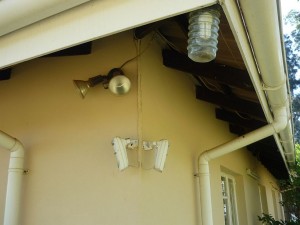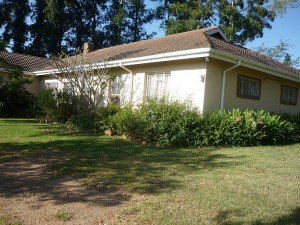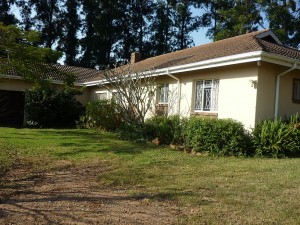On Sunday, Pastor Deon’s sermon was on seals 4 to 6 from Revelation 6. This was the first Sunday that we ate at home, so I was able to spend the afternoon working on the blog entry for last week.

Two motion sensor on one corner of the house. There are a total of 7 such sensors that cover the perimeter of the house and are switched on shortly after sunset, then switched off just before sunup.
Since Joshua and Angie had made a quick trip back to Indiana and would need to drive back on Monday, Allan and Joyce invited everyone to their house for an early Memorial Day family get-together on Sunday. We wanted to talk to everyone on Skype, so Virginia and I played some Rummikub to stay awake. We got to see and talk to everyone after everyone got there about 5pm (11pm our time). As a result, we got to bed late. Unfortunately, it was windy during the night and the outside motion detectors sensed some moving branches and kept ‘squawking’ about every 30 minutes all through the night. I had a good idea which branches were causing the problem, but decided not to go outside to trim them in the dark!

BEFORE — Notice the motion sensor on this corner of the house and the bushes starting to grow up in front of it. Taken about five weeks ago.
Monday, I covered the Maintenance section of the HC100 manual during the morning training. After lunch, I took an exploratory walk down to the river crossing to get a little exercise. In the afternoon and following up on the morning’s discussion, we confirmed that all the transmitters were using newer PA inductors with both copper and silver plating, which results in cooler operation than earlier versions with silver plating alone.
When I got home at sunset, I was ready to cut the bushes which we believed to be the source of motion sensor triggering the night before. To my pleasant surprise, I found that Virginia had already done it and we have had no unwarranted ‘sqawks’ since.
Virginia had written the blog about a ‘typical day’, so I helped add the photos and post it. Then we headed to bed a little early. We needed to, after the short and interrupted night before.
WARNING — if you want to skip technical jargon, you will probably want to skip down to the last three paragraphs!
Tuesday morning, I trained everyone how to calibrate the A-D cards in the metering systems of TX1 and TX3 (TX2 had been calibrated last week to help me remember how to do it). Several were out of calibration because a wrong method of calibration had been used. Five out of six cards calibrated nicely, but the RF metering card of TX3 could not be calibrated. We had to replace the metering input board that ‘reads’ the +/- 15 supply voltage, which voltage is used as a reference for the calibration.
In the afternoon, we started testing a transmitter/antenna combination that has been causing intermittent problems, only to found out that the ‘new’ metering card that we just installed in the morning had a problem and the transmitter would not come on. Fortunately, we did this testing, otherwise it would have caused lost air time later! We found a faulty integrated circuit (IC) on the ‘new’ card and four diodes that were installed wrong. After replacing the IC and correcting the diode problem, we were able to commence the test started earlier.
TX3 was finally brought up on Antenna 6 at a frequency of 7300 kHz and determined that the VSWR was 1.88 and the RF unbalance was 4.2. Both of these are very close to the shutdown limits. We did not have time to do additional testing before the evening transmissions.
As TX 2 was coming up we noticed that it had a error message regarding the 2.73 reference voltage used for temperature monitoring. This was re-calibrated just before programming began. This has proven to be a full day but worthwhile — finding unknown problems and making many corrections!
Wednesday morning was staff meeting in town, then Selema and I went to the transmitter site, while Graham picked up the 1000 foot reel of cable to replace the antenna control cable temporarily repaired last week. When Graham arrived at the site, we resumed the testing of TX3 on Antenna 6 to determine at what frequencies the VSWR and RF unbalance problems ‘peak’ around 7300 kHz. This proved to be excellent training for Graham on how to tune up the transmitter on new frequencies, but revealed nothing conclusive about the antenna problem.
We decided to test TX2, instead of TX3, on Antenna 6, in the afternoon. This entailed, once again, tuning this transmitter on multiple new frequencies. Graham was now getting even more experience.
Thursday morning, we completed the testing of TX2 on Antenna 6 and found that it had slightly higher VSWR on this transmitter, but the RF unbalance was considerably lower. This seems to indicate the problem is not totally with the antenna. So what is the problem?!!
In the afternoon, Klaus wanted us to reinstall the original, now ‘repaired,’ A/D converter card and metering input card into TX3. We ‘happened’ to discover that the water flow indication was showing very high flow without the pump running! This was finally traced to ‘leaky’ diodes on the metering input card and corrected. After the repair, it was found that the water flow sender also had a faulty connection (cold solder joint), which was also corrected. The water flow limits are normally set to about 2.0 minimum and 4.5 maximum, but the maximum limit had been reset to 16 (the maximum possible reading is 10.24) to keep the transmitter running. With the fault on the metering card and with the maximum set to 16, if water flow would have stopped, the transmitter would not have shut down! I then checked the other two transmitters and found that the maximum limits on both had been set to 16, also. I reset them to about 5 and explained that the maximum limit was set specifically to indicate a metering failure. How long all of the transmitters had been operating this way is unknown!
Friday, we decided to continue investigating the Antenna 6 problem, by testing TX3 on Antenna 8, which is electrically identical to Antenna 6. Antenna 8 had slightly higher VSWR and much lower RF unbalance. Actually it looked much like what Antenna 6 looked like to TX2!
After analyzing this information, we decided the problem may be with the routing through the switchbay, since there is a different route to get to Antenna 6 than to Antenna 8. Since Antenna 4 is also similar to Antenna 6 and is accessed by a common route through the switchbay, we decided to test Antenna 4 on TX3. The afternoon was spent in testing again on multiple frequencies on Antenna 4. This time the VSWR was lower and the RF balance was lower. This seems to prove the switchbay routing is not the problem. So, once again, what is the problem??!!
As this transmitter, TX3, started the evening transmission, its computer’s CRT monitor failed. The transmitter will operate without the monitor, but its failure leaves the operator ‘in the dark’ about what is happening. We quickly installed one of the two new LCD monitors that we shipped from Elkhart in March. It sure looks bright compared to how the old CRT monitor looked.

Our grandson, Mark, calls these ‘sample’ bananas. They are about half the size of those normally purchased in the store.
It had been a full week, so Saturday provided a nice break. In the morning we slept in until about 7am, then harvested bananas, nartjies and grenadillas from the garden. From the other side of the fence, Klaus pointed out another stalk of bananas that we had not seen that were really ripe, so we cut down the whole stalk. It looks like we will have to give away some, or eat bananas until ‘they come out our ears!
At noon, we were planning on attending the reunion of a TWR missionary family, who has retired in Swaziland. They had five girls at the same time we had our five boys. At the last minute the reunion was postponed, because it was discovered that one of their grand-children’s passport had expired. Hopefully it will happen before we leave.
This change of plans allowed us to attend the birthday party for Graham’s two daughters that was held in the afternoon. We had a good time celebrating with them, the other TWR families and a couple from FEBA, former co-workers of Graham.

